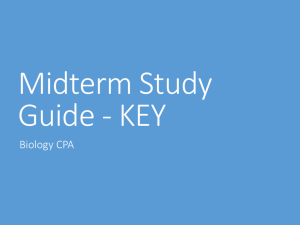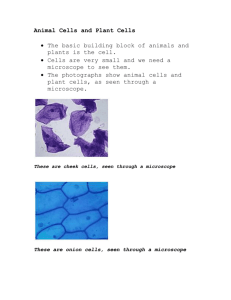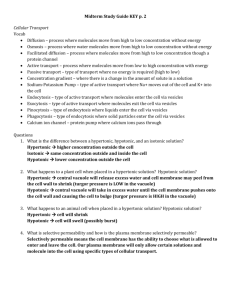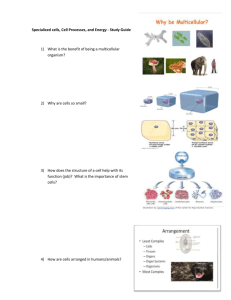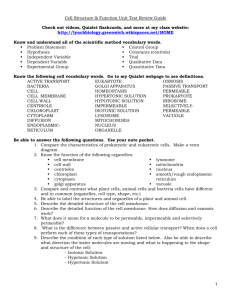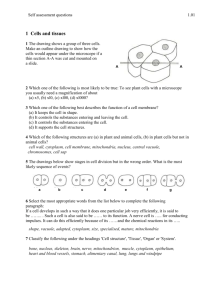Midterm Study Guide KEY PPT
advertisement
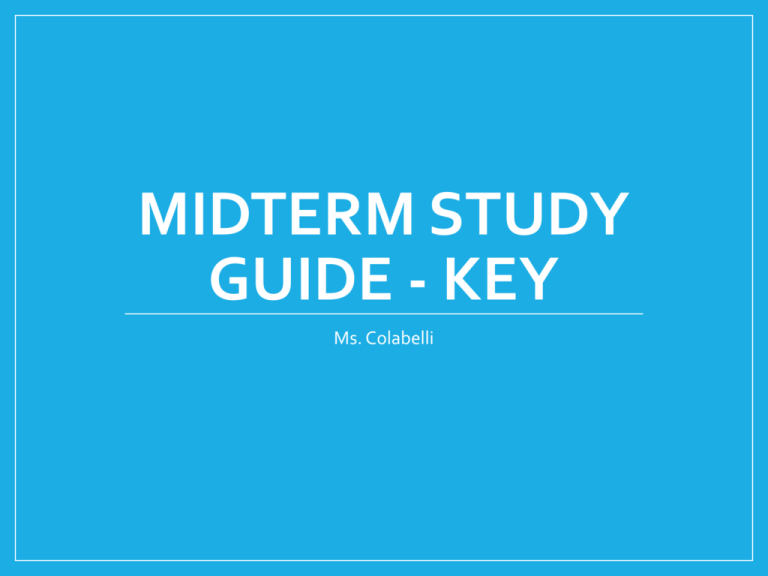
MIDTERM STUDY GUIDE - KEY Ms. Colabelli Scientific Method/Intro to Biology • What are the characteristics of living things? • Have Cells/Contain DNA • Respond to Stimuli • Ability to Reproduce • Grow & Develop • Maintain Homeostasis • Metabolism • Evolve • What is the organization of living things, beginning with cells? • Cells Tissue Organ Organ System Organism • What are the steps of the scientific method? Problem/Question • Observations • Form a hypothesis • Test hypothesis/Design an Experiment • Results/Data Analysis • Conclusion • • How do you calculate the power of magnification? • Multiply the ocular lens by the objective lens. • What are the differences between a compound light microscope and an electron microscope? Light Microscope Electron Microscope Light beams through a specimen Electrons through a specimen Always 2D Can be 3D Can see images 1mm 1 micron Can see images 1 micron 1 nanometer (smaller) Simple Complex • SpongeBob notices that his pal Gary is suffering from slimotosis, which occurs when the shell develops a nasty slime and gives off a horrible odor. His friend Patrick tells him that rubbing seaweed on the shell is the perfect cure, while Sandy says that drinking Dr. Kelp will be a better cure. Sponge Bob decides to test this cure by rubbing Gary with seaweed for 1 week and having him drink Dr. Kelp. After a week of treatment, the slime is gone and Gary’s shell smells better. What is the independent variable of this experiment? • The seaweed rubbing and Dr. Kelp. • What is the dependent variable of this experiment? • Amount of slime on shell and odor. • How might a control been included in this experiment? • If SpongeBob had a snail with no treatment and did the testing with only 1 variable. • • How do you properly focus a slide specimen using a compound light microscope, beginning at scanning and moving up in magnification? • Start in scanning power (4X) and use coarse adjustment to move the stage up and down to focus the image. Next, switch to low power (10X) and use fine adjustment knob to sharpen image. Finally, move to high power (40X) and use fine adjustment knob to get final image of your specimen. Chemistry • What are the bonding properties of carbon? • Carbon can have up to 4 covalent bonds. Carbon can make single, double, or triple bonds. Carbon has 4 valence electrons on its outer shell. • What element do all organic compounds contain? • Carbon or C. • How does hydrogen bonding occur between molecules of water? • • Water is a polar molecule therefore it has a positive and negative side to the molecule. When other water molecules are present, they are attracted to the opposite charge and can make weak hydrogen bonds. What values are given to acids and bases using the pH scale? Acids 0-6, Strong acids 0-4, Acid buffers 4-6 • Neutral 7 • Bases 8-14, Strong bases 10-14, Base buffers 8-10 • Enzymes • What is the function of an enzyme? • Enzymes can speed up a reaction. Enzymes can start a reaction (catalyze). Enzymes can lower the activation energy. • In the picture below, which reaction most likely involves an enzyme? • Reaction 3 Macromolecules Macromolecule Monomer/Polymer Elements/Components involved Examples Protein Amino Acid/Polypeptide C, H, O, N / Carboxyl group, Amino group, R group Meats Lipids Fatty acids/ Triglycerides, Phospholipids, Waxes, Steroids C, H / Glycerol, Fatty acids, Phosphate group (phospholipids) Oils Carbohydrates Monosaccharide/ Polysaccharide C, H, O / Sugars Bread Nucleotide/DNA or RNA C, H, O, N, P / Sugar, Phosphate group, Nitrogenous base DNA Nucleic Acids • What reagents are used to test for each of the macromolecules? Lipids • Paper Positive result: Transparent, Negative result: Opaque • Carbohydrates • Benedict’s solution Positive result: Green/Orange, Negative result: Blue • Proteins • Biuret Positive result: Purple, Negative result: Blue • Starch • Iodine Positive result: Black, Negative result: Red/orange • Cell Structure and Function • List the scientists involved with early cell discoveries and identify their contribution. Robert Hooke Saw cork cells under microscope • Anton van Leeuwenhoek Made first light microscope and saw first cells • • How is surface area relevant to cell size? • Cell size is limited by its surface area. As cell size decreases, surface area increases. • What are the differences between prokaryotes and eukaryotes? Prokaryotes Smaller Bacteria/Archaea Unicellular No membrane bound nucleus (nucleoid) Eukaryotes Larger Plants/Animals Multicellular Membrane bound nucleus • What are the differences between plant and animal cells? Plant Nucleus is off centered Chloroplasts Cell wall Central vacuole Animal Nucleus in center Centrioles Lysosomes Cellular Transport • What is the difference between a hypertonic, hypotonic, and an isotonic solution? Hypertonic higher concentration outside the cell • Isotonic same concentration outside and inside the cell • Hypotonic lower concentration outside the cell • • What happens to a plant cell when placed in a hypertonic solution? Hypotonic solution? Hypertonic central vacuole will release excess water and cell membrane may peel from the cell wall to shrink (turgor pressure is LOW in the vacuole) • Hypotonic central vacuole will take in excess water until the cell membrane pushes onto the cell wall and causing the cell to bulge (turgor pressure is HIGH in the vacuole) • • What happens to an animal cell when placed in a hypertonic solution? Hypotonic solution? Hypertonic cell will shrink • Hypotonic cell will swell (possibly burst) • • What is selective permeability and how is the plasma membrane selectively permeable? • Selectively permeable means the cell membrane has the ability to choose what is allowed to enter and leave the cell. Our plasma membrane will only allow certain solutions and molecule into the cell using specific types of cellular transport. Photosynthesis • What is the role of chlorophyll in photosynthesis? • Chlorophyll absorbs the light energy from the sun and transfers it to chemical energy during the photosystem reactions. • What happens during the light-dependent reactions? During the light- independent reactions? • Light dependent occur in the thylakoid membranes of the chloroplast. Require sunlight in order to occur. Photosystems I and II take place during these reactions. Oxygen is made and the ETC allows for chemiosmosis to take place producing ATP. • Why do we see the color green when light is absorbed by chlorophyll? • Chlorophyll absorbs all colors from light except for green. Green is reflected therefore that is the color you see. • What are the products of each of the reactions of photosynthesis? Photosystem I & II O2 and ATP • Calvin cycle glucose (C6H12O6) • • Compare & Contrast C3, C4, and CAM plants • C3 and C4 plants usually have their stomata open during the day and CAM plants only have their stomata open at night time to avoid drying out. • What are the factors that affect the rate of photosynthesis, and how do they affect them? Temperature Increases the rate to a certain point then decreases if too hot • CO2 concentration Increases the rate to a certain point, then stays the same • Light intensity Increases the rate to a certain point, then stays the same • • What is the source of oxygen produced during photosynthesis? • When water is split during Photosystem II. Cellular Respiration • How are photosynthesis and cellular respiration a circular process? • The products of one reaction are the starting reactants of the other. They compliment each other. • What are the stages of aerobic respiration? • Aerobic respiration is broken down into Glycolysis and Cellular Respiration (Kreb’s Cycle & Electron Transport Chain). • What are the two types of fermentation? • What are their products? The two types of fermentation are lactic acid fermentation and alcoholic fermentation. The products are lactic acid and alcohol respectively. • What is the product of glycolysis? • The product of glycolysis are 2 pyruvic acid molecules that will be used in the Kreb’s cycle. • What process produces the most amount of ATP? • The electron transport chain.
